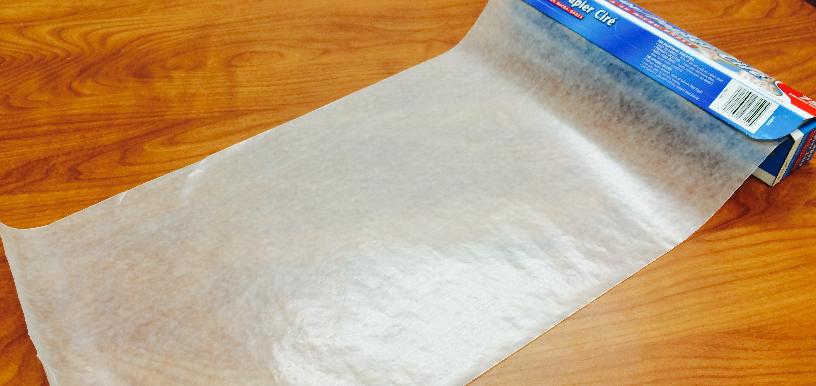In 1927 The Reynolds Company made wax paper a household kitchen product in when they put it in a box with a serrated-edge cutter. The Miracle of Wax Paper. Thomas Edison is given credit for its invention However, there is some controversy surround that. Cutting to the chase, there is really nothing else like it when it comes to kitchen aides.
Wax paper can be used for some light cleaning tasks around the house due to its non-stick and slightly waxy surface. Here are a few hacks you might not be aware of.
Dusting:
Wax paper can be used to dust surfaces like shelves, countertops, or furniture. The waxy surface helps capture dust and light debris, and the paper is gentle enough not to scratch delicate surfaces.
Polishing chrome:
Use wax paper to buff and polish chrome faucets, fixtures, or appliances. The waxy surface can help remove water spots and fingerprints, leaving the chrome with a bit of a shine.
Cleaning window tracks:
Wax paper can be used to clean dirt and debris from window tracks. Fold the wax paper to fit the track and run it along the length of the track to pick up dirt.
Unsticking zippers:
Run a sheet of wax paper along a stubborn zipper to help lubricate the teeth and make it easier to open and close.
Cleaning a can opener:
After washing a can opener with soap and water, run a sheet of wax paper through it to help remove any remaining debris from the gears and cutting edge.
Protecting surfaces:
Use wax paper to protect surfaces while working on DIY or craft projects, such as painting, gluing, or using markers. The waxy surface prevents liquids from soaking through and makes it easy to clean up spills.
Deodorizing shoes:
Crumple up some wax paper and place it in shoes overnight to help absorb odors.
Keep in mind that wax paper is not ideal for heavy-duty cleaning or scrubbing, as it can tear easily and is not as absorbent as other cleaning materials like paper towels or microfiber cloths. For more demanding cleaning tasks, it’s best to use the appropriate cleaning tools and products designed for the job.
As an Alternative to Swiffer Sweeper Refills
Wax paper can be used as a makeshift alternative to Swiffer Sweeper refills for light dusting tasks. This may be good if you runout of the refills or caught in a pinch. However, it might not be as effective as the actual Swiffer refills, which are designed to trap and hold dirt, dust, and hair with their electrostatic properties and textured surfaces.
To use wax paper on a Swiffer Sweeper:
Cut a piece of wax paper slightly larger than the size of the Swiffer Sweeper head. Fold the edges of the wax paper over the edges of the Swiffer Sweeper head to hold it in place. You can also use rubber bands to secure the wax paper if necessary. Use the Swiffer Sweeper with the wax paper attached to dust your floors or other surfaces.
Keep in mind that wax paper is not as effective at trapping dirt and debris as a Swiffer refill, and it may require more frequent replacement. Additionally, it won’t have the same scrubbing ability for tougher messes or stuck-on debris.
For a more effective reusable alternative, consider using microfiber cloths or a washable Swiffer-compatible cloth. These options can be washed and reused, providing better cleaning performance and cost savings in the long run.
More Common Uses
Prevent messes:
Place a sheet of wax paper under your cutting board or on your countertop to catch crumbs, juices, or peels while chopping fruits or vegetables. This makes cleanup a breeze.
Rolling out dough:
Use wax paper to roll out pie crusts, cookie dough, or other pastries. Place a sheet of wax paper under the dough and another sheet on top to prevent sticking to the rolling pin.
Cake decorating:
Place a sheet of wax paper under the edges of your cake while frosting or decorating to catch any excess frosting or sprinkles. Once you’re finished, carefully remove the wax paper for a clean presentation.
Separating layers:
Wax paper is perfect for separating layers of sticky foods like cookies, candies, or burger patties. Stack the items with a sheet of wax paper between each layer to prevent them from sticking together.
Piping bags:
Make a makeshift piping bag for frosting or other soft mixtures by shaping a sheet of wax paper into a cone and snipping off the tip. Fill the cone with your mixture and squeeze gently to pipe it out.
Food storage:
Use wax paper to wrap sandwiches, cheese, or other items that don’t require an airtight seal. It can help keep them fresh and prevent them from drying out.
Microwave protection:
Place a sheet of wax paper over your plate or bowl in the microwave to prevent splatters and make cleaning easier.
Baking liner:
While wax paper is not heat-resistant like parchment paper, you can use it to line your cake pans for easy removal. Just make sure the wax paper does not come into direct contact with the oven’s heating elements.
Freezing:
Prevent clumping when freezing items like berries, meatballs, or cookie dough by placing them on a wax paper-lined baking sheet in a single layer. Once frozen, transfer the items to a freezer bag for storage.
Funnel:
Roll a sheet of wax paper into a funnel shape to easily transfer dry ingredients like flour, sugar, or spices from one container to another without spilling.
Remember that wax paper is not suitable for high-heat applications like baking in the oven, as it can smoke or catch fire. Use parchment paper or a silicone baking mat for those purposes.

